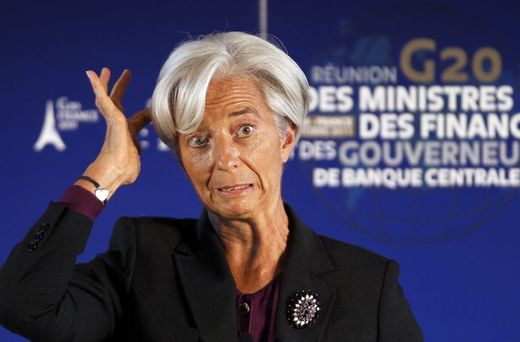The Cycles Roll On
On an almost predictable, totally certain cyclic basis, financial market crises throw up one pat question, with only one pat answer. What does the survival of our current finance, monetary and economic system depend on? It depends on people preferring fiat money more than gold.
From the moment in 1971 when US president Nixon "broke the link with gold", the dollar floated free and made the cyclic attempts to demonetize gold a permanent feature of the financial market system, and the collateral cause of its regular and cyclic crises. To be sure, the banksters operating this permanent rearguard action fighting reality are not going to tell us when the next "reset" will happen - but it will be soon.
After the dollar was taken off the gold standard in 1971, bankers had to run harder and faster to keep fiat money assets performing better than precious metals, and during the cyclic crises they have to take off the gloves to beat down the rising value of gold against declining fiat money. Usually presented as a permanent struggle to only bolster and save the US dollar, it in fact concerns all fiat moneys and all financial assets and instruments. Related parts of the struggle include the permanent need to lie about inflation and "positively influence inflation expectations" now featuring the prevention of deflation from eating away confidence, on the other side of the mirror.
UK Gold Dump

In less than 3 years over 17 auctions, Brown dumped about 400 tons of gold.
This was the trigger moment for a long and rabid growth of equity and commodity prices, in fact of any financial asset that could be invented and traded. The "historic low" for gold at the turn of the century ran back-to-back with what Wall Street veteran financial lawyer Jim Rickards called the "derivatization of financial markets", the creation of untold massive quantities of tradable paper which as Rickards says are "used to manipulate underlying physical markets such as oil, copper and gold" as well as equities, currencies, interest rates and anything else which can be traded. Soon, the market became much too big to beat, but also asphyxiated and drowned itself in paper.
As Rickards has many times described along with other experts, saving fiat and destroying gold opened the door to an exponential growth of both the size and variety pf what are politely called "off-balance-sheet instruments" hidden by all the major banks and impossible to quantify let alone monitor. And at all times able to implode.
Quirks and Foibles
The gold market is above all tiny in physical size. Annual mine output works out at an average of about 0.33 grams per person on a world basis, per year. It is the classic canary in the coal mine. Being small and ultra-opaque, the gold market is ultra-easy to manipulate. When this rigging gets ultra-extreme, the canary chokes. The $200-per-ounce crash of the gold price in 3 days through April 12 and 15, 2013 was a perfect example.
The basic problem is very simple. Five years after the near fatal collapse of the world's financial system we have no choice but to conclude that central bankers and politicians have upped the ante, bought time, and engaged in increasingly eccentric and obsessional playacting which they call "trying to solve the credit crisis" - by creating even more debt. The money printing binge by the world's central bankers has expanded only central bank balance sheets by at least $10 trillion in 5 years. This newly created money was and is used by the central bankers to buy national debt, parking the ballooning debt of governments at their own central banks. Supposedly, this is The Solution.
For as long as the gold price can be kept down "things will be alright". Another part of circus act has it that as long as the oil price can be kept at $100 a barrel "things will be alright". Yet another part of the playact is that interest rates have to be near-zero, and smaller-sized savings accounts can be seized at any time, meaning that things are alright.
Reporting from Davos, January 25, AP said that IMF managing director Christine Lagarde warned Forum delegates of the risks for the "global economic recovery" arising from the US Fed's "taper down", from $85 billion a month, to $75 billion a month. This tapering has already caused what Lagarde claimed was the deflation trend in Europe and wavering stock markets - and she did not mention rising gold prices or falling oil prices. As well as shoring up stock markets round the world, the new money had flown to emerging economies causing currencies as wide ranging as the Indian rupee, Brazilian real and Indonesian rupiah to inflate and gain ground. Lagarde told the Davos Forum that withdrawal of this hot money could prompt a reverse process and put these currencies under pressure, which is already happening. She also expressed her concern that inflation in Europe was "much too low".
In other words, the printing spree has to continue, gold prices have to be kept low, equities and oil prices have to be kept high, and "things will be alright".
Don't Demand Delivery
In a stark revealing contrast to fiat paper asset trading, where "future value" turns peanuts into whales and molehills into mountains, gold of the physical bullion type for central banks and the IMF has to stay out of sight and motionless. Reported this week ending 25 January by the bastion of fiat money correct, the UK newspaper Financial Times, the intended repatriation of 700 tons of gold owned by the German central bank, nicknamed 'BuBa', from New York and Paris has hit a long slow patch. Announced a year ago, the BuBa repatriation program has failed to materialize. For the FT this is only reveals German brutality and impatience. The FT explained the prevarication this way: "Although a couple of jumbo jets could have managed the transatlantic removal, it made security sense to ship the load in smaller consignments. Just how small, and over how long, has only just become apparent".
In December, BuBa president Jens Weidmann admitted that only 37 tons had so far been returned to Germany. At this leisurely rate it will take at least 20 years for BuBa to recover it gold. The FT reported that in the meantime "Herr Weidmann is welcome to come and look through the bars in the Federal Reserve's vaults, but the question is: whose bars are they?".
Brien Lundin of the New Orleans Investment Conference interviewed on Future Money trends this week said "It feels like we're off to a really good start in 2014", before admitting he had never before seen a gold market where especially Asian physical demand is soaring - but prices are falling or weak - and even junior gold mining companies sitting on rich lodes have problems staying in business at gold prices around $1,250 an ounce. As he said, and many others say, the US Fed's inability politely called unwillingness to send back lent gold from Germany to Germany's BuBa probably means the Fed has not got the gold to do it. He said, January 20: " It almost assuredly does not have the gold. There's conflicting reports about whether the gold was melted before it was sent back to Germany, or whether after it was sent back to Germany the German Central Bank itself melted the gold and recast it" but the bottom line is Germany will likely only ever receive a half of the gold it lent to the US Fed.
Lundin went on to explain that through the 1990s the German BuBa and other central banks treated gold as a "depreciating asset" they could swap and trade - and sell - replacing the real gold with "subpar gold" bars with the same serial numbers stamped on them, in their vaults. They reckoned that at some future stage when the gold price had been sufficiently pushed lower, they could buy back real gold using the IOUs they held. But even at today's gold market prices, this would be "prohibitively costly" - hence the delay by the Fed in marshaling enough subpar gold to send back to Germany.
The Chinese 'Lehman Bros Moment'
Since Lehman Brothers investment bank collapsed in 2008, the level of private domestic economy credit in China, from the central bank, private banks and regional authorities downward, is estimated to have risen from $9 trillion to an astounding $23 trillion. That is an increase of $14 trillion in a little bit more than 5 years.
Anybody asking why China in a few months since mid-2013 has probably purchased about 2700 tons of physical gold - equal to one full year's world gold mine output - can stop at that figure. At the same time, much of the "missing $14 trillion" has flowed into stocks, bonds and real estate in the US, Europe, Japan and a few other key markets.
To be sure, this debt bubble helped fuel tremendous economic growth in China, but now a swath of Chinese companies know they up to their ears in debt. Estimates given by financial journalists in several countries, like the UK's Daily Telegraph in recent weeks suggest Chinese companies will pay out the equivalent of about a trillion dollars in loan interest payments in 2014 alone. This is the same amount as total US Federal Reserve "quantitative easing" at the pre-taper rate of $85 billion a month.
And the Chinese economy is slowing.
The Chinese corporate debt mountain is also more than twice the amount that the US government will pay in interest on sovereign debt in 2014. While the US Fed, the ECB, the Bank of Japan and the Bank of England have all been criticized for creating too much money in 2013, what has been happening in China beats all of their efforts, combined.
Signaling exactly what this means, Deutsche Bank shares tumbled last week following a "surprise" fourth-quarter 2013 loss - mostly due to a steep drop in debt trading revenues, as well as large regulatory fines for both gold and energy market-rigging, and heavy litigation and restructuring costs, all of which prompted the bank to warn of a "challenging 2014". Major European banks like Deutsche are heavily exposed to Chinese debt and for Deutsche, revenues at its important debt-trading division fell 31 percent in the 3 months of Sept-Dec 2013, a much bigger drop than at US and other European rivals, which also suffered from sluggish fixed-income trading.
The main point is however hidden by the "Emerging market debt crisis". Debt in the developed countries runs at a much higher and unsustained level. Debt growth in the developed countries is at historic high rates, called "structural", and impossible to reduce without debt repudiation, restructuring or dilution as numerous IMF working papers have warned in 2013. At some key "Lehman Bros moment" the gold price must take off, signaling that the unreal and unequal challenge of protecting fiat money has been lost.
As that time draws near, smart investors might brace themselves... for impact.





Germany melted the bars to make certain that they weren't gold plated tungsten, which have been showing up around the world, and to re-refine to assure good delivery purity. The US reportedly had 400 tons of tungsten shipped to a private gold refiner a few years ago. The reason is now clear.